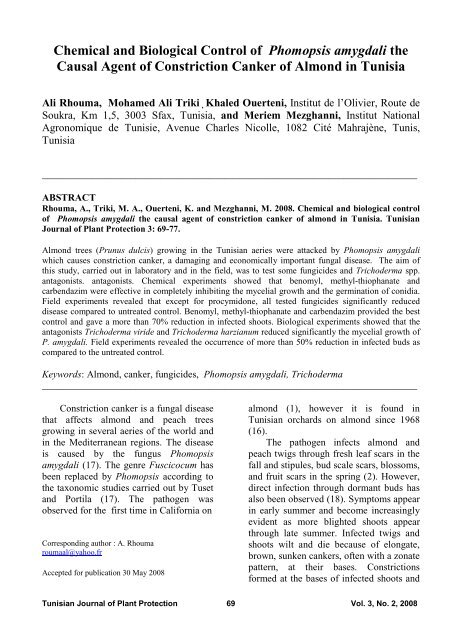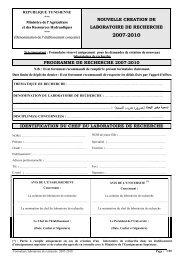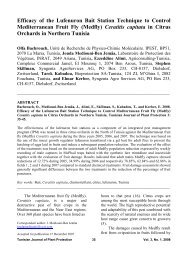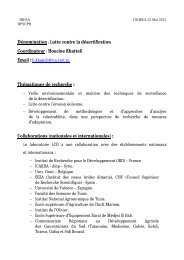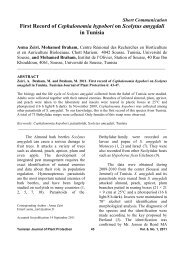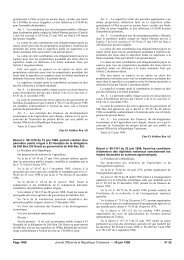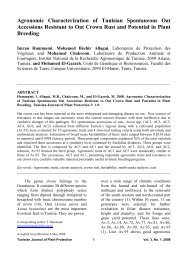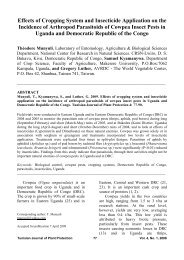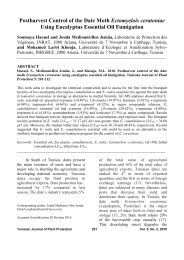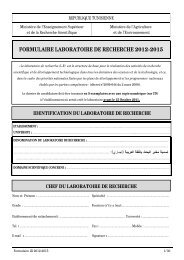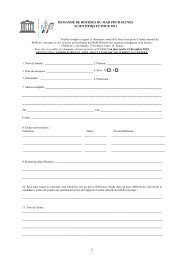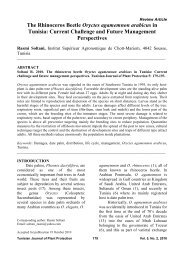Chemical and Biological Control of Phomopsis amygdali the ... - Iresa
Chemical and Biological Control of Phomopsis amygdali the ... - Iresa
Chemical and Biological Control of Phomopsis amygdali the ... - Iresa
You also want an ePaper? Increase the reach of your titles
YUMPU automatically turns print PDFs into web optimized ePapers that Google loves.
<strong>Chemical</strong> <strong>and</strong> <strong>Biological</strong> <strong>Control</strong> <strong>of</strong> <strong>Phomopsis</strong> <strong>amygdali</strong> <strong>the</strong><br />
Causal Agent <strong>of</strong> Constriction Canker <strong>of</strong> Almond in Tunisia<br />
Ali Rhouma, Mohamed Ali Triki , Khaled Ouerteni, Institut de l’Olivier, Route de<br />
Soukra, Km 1,5, 3003 Sfax, Tunisia, <strong>and</strong> Meriem Mezghanni, Institut National<br />
Agronomique de Tunisie, Avenue Charles Nicolle, 1082 Cité Mahrajène, Tunis,<br />
Tunisia<br />
____________________________________________________________________________<br />
ABSTRACT<br />
Rhouma, A., Triki, M. A., Ouerteni, K. <strong>and</strong> Mezghanni, M. 2008. <strong>Chemical</strong> <strong>and</strong> biological control<br />
<strong>of</strong> <strong>Phomopsis</strong> <strong>amygdali</strong> <strong>the</strong> causal agent <strong>of</strong> constriction canker <strong>of</strong> almond in Tunisia. Tunisian<br />
Journal <strong>of</strong> Plant Protection 3: 69-77.<br />
Almond trees (Prunus dulcis) growing in <strong>the</strong> Tunisian aeries were attacked by <strong>Phomopsis</strong> <strong>amygdali</strong><br />
which causes constriction canker, a damaging <strong>and</strong> economically important fungal disease. The aim <strong>of</strong><br />
this study, carried out in laboratory <strong>and</strong> in <strong>the</strong> field, was to test some fungicides <strong>and</strong> Trichoderma spp.<br />
antagonists. antagonists. <strong>Chemical</strong> experiments showed that benomyl, methyl-thiophanate <strong>and</strong><br />
carbendazim were effective in completely inhibiting <strong>the</strong> mycelial growth <strong>and</strong> <strong>the</strong> germination <strong>of</strong> conidia.<br />
Field experiments revealed that except for procymidone, all tested fungicides significantly reduced<br />
disease compared to untreated control. Benomyl, methyl-thiophanate <strong>and</strong> carbendazim provided <strong>the</strong> best<br />
control <strong>and</strong> gave a more than 70% reduction in infected shoots. <strong>Biological</strong> experiments showed that <strong>the</strong><br />
antagonists Trichoderma viride <strong>and</strong> Trichoderma harzianum reduced significantly <strong>the</strong> mycelial growth <strong>of</strong><br />
P. <strong>amygdali</strong>. Field experiments revealed <strong>the</strong> occurrence <strong>of</strong> more than 50% reduction in infected buds as<br />
compared to <strong>the</strong> untreated control.<br />
Keywords: Almond, canker, fungicides, <strong>Phomopsis</strong> <strong>amygdali</strong>, Trichoderma<br />
____________________________________________________________________________<br />
Constriction canker is a fungal disease<br />
that affects almond <strong>and</strong> peach trees<br />
growing in several aeries <strong>of</strong> <strong>the</strong> world <strong>and</strong><br />
in <strong>the</strong> Mediterranean regions. The disease<br />
is caused by <strong>the</strong> fungus <strong>Phomopsis</strong><br />
<strong>amygdali</strong> (17). The genre Fuscicocum has<br />
been replaced by <strong>Phomopsis</strong> according to<br />
<strong>the</strong> taxonomic studies carried out by Tuset<br />
<strong>and</strong> Portila (17). The pathogen was<br />
observed for <strong>the</strong> first time in California on<br />
Corresponding author : A. Rhouma<br />
roumaal@yahoo.fr<br />
Accepted for publication 30 May 2008<br />
almond (1), however it is found in<br />
Tunisian orchards on almond since 1968<br />
(16).<br />
The pathogen infects almond <strong>and</strong><br />
peach twigs through fresh leaf scars in <strong>the</strong><br />
fall <strong>and</strong> stipules, bud scale scars, blossoms,<br />
<strong>and</strong> fruit scars in <strong>the</strong> spring (2). However,<br />
direct infection through dormant buds has<br />
also been observed (18). Symptoms appear<br />
in early summer <strong>and</strong> become increasingly<br />
evident as more blighted shoots appear<br />
through late summer. Infected twigs <strong>and</strong><br />
shoots wilt <strong>and</strong> die because <strong>of</strong> elongate,<br />
brown, sunken cankers, <strong>of</strong>ten with a zonate<br />
pattern, at <strong>the</strong>ir bases. Constrictions<br />
formed at <strong>the</strong> bases <strong>of</strong> infected shoots <strong>and</strong><br />
Tunisian Journal <strong>of</strong> Plant Protection 69<br />
Vol. 3, No. 2, 2008
leaf symptoms produced well beyond <strong>the</strong><br />
infection site result from a toxin named<br />
fusicoccin (3, 7). Gumming is commonly<br />
associated with cankers, but it is not a<br />
good diagnostic characteristic because<br />
o<strong>the</strong>r canker pathogens also cause<br />
gumming. Most fruit on infected shoots<br />
shrivel <strong>and</strong> drop <strong>of</strong>f as <strong>the</strong> shoots<br />
desiccate. Shoots having more advanced<br />
cankers, usually as a result <strong>of</strong> fall<br />
infection, are <strong>of</strong>ten dead before or during<br />
bloom <strong>and</strong> fruit set. A quantitative survey<br />
in commercial New Jersey orchards<br />
conducted in 1997 <strong>and</strong> 1998 revealed yield<br />
losses <strong>of</strong> 28.5 <strong>and</strong> 21.0%, which translated<br />
into economic losses <strong>of</strong> $4,009 <strong>and</strong> $2,803<br />
per ha, respectively (8).<br />
A review <strong>of</strong> fungicides used against<br />
<strong>the</strong> fungi indicated that <strong>the</strong> mercurial <strong>and</strong><br />
arsenic fungicides were effective in<br />
controlling <strong>the</strong> disease; however <strong>the</strong>y were<br />
banned from use on crops as foliar sprays<br />
(3, 4). In order to substitute <strong>the</strong>se products,<br />
dithiocarbamates <strong>and</strong> benzimidazoles were<br />
used but <strong>the</strong>y were proved less efficient<br />
(4). Lalancette <strong>and</strong> Robison (9)<br />
demonstrated that chlorothalonil was <strong>the</strong><br />
most efficient fungicide followed by<br />
captan, azoxystrobin <strong>and</strong> mycobutanil. As<br />
regards to <strong>the</strong> period spray, <strong>the</strong> lowest<br />
canker incidence <strong>and</strong> severity was obtained<br />
when fungicides were applied during both<br />
fall <strong>and</strong> spring.<br />
With <strong>the</strong> exception <strong>of</strong> <strong>the</strong>se<br />
fungicides, few products are registered for<br />
use during <strong>the</strong> critical periods <strong>of</strong> host<br />
susceptibility (fall), <strong>and</strong> efficacy <strong>of</strong> several<br />
new active ingredients is currently<br />
unknown. O<strong>the</strong>rwise, in recent decades,<br />
elevated awareness <strong>of</strong> <strong>the</strong> impacts <strong>of</strong><br />
pesticide use on <strong>the</strong> environment <strong>and</strong><br />
human health has resulted in efforts to<br />
reduce reliance on chemical controls.<br />
Several countries have instituted more<br />
stringent regulation <strong>of</strong> pesticide<br />
manufacture, registration <strong>and</strong> use, <strong>the</strong>reby<br />
increasing <strong>the</strong> cost, <strong>and</strong> decreasing <strong>the</strong><br />
availability <strong>of</strong> <strong>the</strong>se tools. In many cases,<br />
<strong>the</strong> pests <strong>the</strong>mselves have indicated <strong>the</strong><br />
need for change, with pesticide resistance<br />
now a common reality in many weeds,<br />
insects <strong>and</strong> diseases. The need for<br />
alternatives to pesticides is imperative.<br />
Several reports indicated that biologically<br />
based technologies such as biological<br />
control could be more widely used to solve<br />
pressing needs in pest management. In <strong>the</strong><br />
case <strong>of</strong> P. <strong>amygdali</strong>, little is known about<br />
<strong>the</strong> potential antagonistic effects <strong>of</strong><br />
Trichoderma species. Since it is generally<br />
believed that a combination <strong>of</strong> biological<br />
<strong>and</strong> chemical control measures is<br />
necessary to minimize losses caused by<br />
plant pathogenic fungi, <strong>the</strong> major aim <strong>of</strong><br />
<strong>the</strong> present study was to investigate <strong>the</strong><br />
management strategy for constriction<br />
canker using biological <strong>and</strong> chemical<br />
treatments. Different actives ingredients<br />
(benomyl, carbendazim, methylthiophanate,<br />
procymidone, cuprocuivre)<br />
were applied during <strong>the</strong> fall <strong>and</strong> spring<br />
periods. As regards to <strong>the</strong> antagonists<br />
agents, three species were tested:<br />
Trichoderma viride, Trichoderma<br />
harzianum <strong>and</strong> a local species <strong>of</strong><br />
Trichoderma.<br />
MATERIALS AND METHODS<br />
Fungal isolation <strong>and</strong> suspension<br />
preparation. P. <strong>amygdali</strong> was isolated<br />
from constriction canker <strong>of</strong> twigs sampled<br />
from <strong>the</strong> cultivar “Kossentiny”. It was<br />
grown from a single spore <strong>and</strong> maintained<br />
on Potato Dextrose Agar (PDA, 200 g <strong>of</strong><br />
potato, 20 g <strong>of</strong> dextrose <strong>and</strong> 20 g <strong>of</strong> agar).<br />
Conidia were collected from 10 day-old<br />
cultures, suspended in 0,001% Tween 20<br />
(polyoxyethylene sorbitan monolaurate).<br />
They were <strong>the</strong>n filtered through glass<br />
wool, washed three times with distilled<br />
water, <strong>and</strong> <strong>the</strong>n re-suspended in water to<br />
give a final concentration <strong>of</strong> 5x10 4<br />
spores/ml,estimated by counting with a<br />
Malassez slide.<br />
Tunisian Journal <strong>of</strong> Plant Protection 70<br />
Vol. 3, No. 2, 2008
Experimental design. A local almond<br />
cultivar (Kossentiny) located in a<br />
commercial orchard in <strong>the</strong> region <strong>of</strong> Bir<br />
Mellouli (Sfax, Tunisia) was chosen for<br />
study. Almond trees had histories <strong>of</strong> severe<br />
constriction canker. For each treatment,<br />
three homogeneous trees were selected<br />
with approximately 4 to 5 m in diameter<br />
<strong>and</strong> 3 to 4 m in high. For each almond tree,<br />
ten homogenous shoots were selected <strong>and</strong><br />
five buds in each shoot were marked. The<br />
design employed was a r<strong>and</strong>omized<br />
complete block with three replicates.<br />
<strong>Chemical</strong> treatments. Different<br />
fungicides were assayed for <strong>the</strong>ir activity<br />
against P. <strong>amygdali</strong> in vitro <strong>and</strong> in planta.<br />
Evaluated fungicides were: benomyl<br />
(Benlate 50), procymidone (Sumisclex,<br />
50WP), methyl-thiophanate (Pelt 44),<br />
carbendazim (Bavistin FL), metallic<br />
copper (Cuprocuivre 50WP). All<br />
fungicides were suspended in water <strong>and</strong><br />
tested at 1/10, 1/5, 1, <strong>and</strong> 3/2 <strong>of</strong> <strong>the</strong><br />
registration dose (RD).<br />
Laboratory studies. Germination essay<br />
was carried out in cavity slides. One<br />
hundred µl <strong>of</strong> <strong>the</strong> test suspension <strong>and</strong> 50 µl<br />
<strong>of</strong> <strong>the</strong> conidial suspension were pipetted<br />
onto cavity slides <strong>and</strong> <strong>the</strong>n placed on<br />
Whatman N°1 filter paper in Petri dishes<br />
<strong>and</strong> held at 25°C, with a 12 h-photoperiod<br />
<strong>of</strong> approximately 145 µE/m 2 /sec. Counts<br />
<strong>of</strong> germinated conidia were taken 48 h<br />
post-incubation, <strong>and</strong> calculated means<br />
were based on 100 measurements. Four<br />
replications <strong>of</strong> each concentration, <strong>and</strong> two<br />
separate tests were performed.<br />
Fungicides were also tested for <strong>the</strong>ir<br />
activity against mycelial growth.<br />
Suspension <strong>of</strong> fungicides were prepared in<br />
sterile distilled water <strong>and</strong> added to PDA<br />
medium at approximately 50°C to yield to<br />
<strong>the</strong> appropriate concentration. After<br />
mixing, <strong>the</strong> amended PDA was dispensed<br />
into 9-cm-diameter Petri dishes <strong>and</strong><br />
allowed to cool. Six-mm-diameter plugs <strong>of</strong><br />
agar from actively growing medium <strong>of</strong> P.<br />
<strong>amygdali</strong>, grown on PDA, were placed<br />
with <strong>the</strong> surface mycelium face down on<br />
<strong>the</strong> medium. The plates were <strong>the</strong>n<br />
incubated at 25°C, <strong>and</strong> mycelial growth<br />
was measured at 24 h intervals. Four<br />
replications <strong>of</strong> each concentration were<br />
used, <strong>and</strong> three separate tests were<br />
performed.<br />
Field studies. Fungicides were applied<br />
during both fall <strong>and</strong> spring periods. The<br />
disease assessment was carried out from<br />
mid-June trough <strong>the</strong> end <strong>of</strong> July by<br />
counting <strong>the</strong> number <strong>of</strong> constriction<br />
cankers <strong>and</strong> determining disease incidence<br />
<strong>and</strong> severity on <strong>the</strong> base <strong>of</strong> <strong>the</strong> percentage<br />
<strong>of</strong> infected shoots <strong>and</strong> <strong>the</strong> average number<br />
<strong>of</strong> cankers per shoot respectively.<br />
<strong>Biological</strong> Treatments. <strong>Biological</strong><br />
control <strong>of</strong> <strong>Phomopsis</strong> canker was<br />
performed with <strong>the</strong> antagonists fungi<br />
Trichoderma viride, T. harzianum <strong>and</strong><br />
Trichoderma sp. isolated in Tunisia.<br />
Laboratory experiments. In vitro tests<br />
were achieved by confrontation <strong>of</strong> isolates<br />
<strong>of</strong> Trichoderma <strong>and</strong> P. <strong>amygdali</strong> in Petri<br />
dishes. Six-mm-diameter plugs <strong>of</strong> agar<br />
from actively growing medium <strong>of</strong> P.<br />
<strong>amygdali</strong> <strong>and</strong> <strong>the</strong> antagonistic fungi were<br />
placed on PDA at a distance <strong>of</strong> 30 mm.<br />
Plugs were symmetrically <strong>of</strong> <strong>the</strong> dish<br />
center. The plates were <strong>the</strong>n incubated at<br />
25°C, <strong>and</strong> mycelial growth was measured<br />
at 24 h intervals. Four replications <strong>of</strong> each<br />
concentration were used, <strong>and</strong> three<br />
separate tests were performed. The<br />
inhibition percentage <strong>of</strong> mycelium growth<br />
was determined according to <strong>the</strong> formula<br />
<strong>of</strong> Fokkema (5) <strong>and</strong> Sy (14):<br />
M% = 100 x (M 0 – M 1 )/M 0 ,<br />
where M 0 was <strong>the</strong> mycelial growth <strong>of</strong><br />
<strong>Phomopsis</strong> alone <strong>and</strong> M 1 <strong>the</strong> mycelial<br />
growth <strong>of</strong> P. <strong>amygdali</strong> in presence <strong>of</strong> <strong>the</strong><br />
antagonist.<br />
Tunisian Journal <strong>of</strong> Plant Protection 71<br />
Vol. 3, No. 2, 2008
Field experiments. Antagonists were<br />
applied during both fall <strong>and</strong> spring periods.<br />
Spore suspension <strong>of</strong> Trichoderma (10 6<br />
spores/ml) was deposed on <strong>the</strong> leaves<br />
scars. The disease assessment was carried<br />
out from mid-June trough <strong>the</strong> end <strong>of</strong> July<br />
by counting <strong>the</strong> number <strong>of</strong> constriction<br />
cankers <strong>and</strong> determining disease incidence<br />
<strong>and</strong> severity on <strong>the</strong> base <strong>of</strong> <strong>the</strong> percentage<br />
<strong>of</strong> infected shoots <strong>and</strong> <strong>the</strong> average number<br />
<strong>of</strong> cankers per shoot respectively.<br />
Statistical analysis. Analysis <strong>of</strong><br />
variance (ANOVA) was performed using<br />
<strong>the</strong> general linear models (GLM)<br />
procedure <strong>of</strong> <strong>the</strong> SPSS s<strong>of</strong>tware (version<br />
13) means were separated by Duncan test,<br />
<strong>and</strong> responses were judged significant at<br />
<strong>the</strong> 5% level (P = 0.05).<br />
RESULTS<br />
Favorable conditions for disease<br />
development occurred during <strong>the</strong><br />
experiments essays. Fall <strong>and</strong> spring<br />
seasons had almost similar environment<br />
conditions except in spring 2002, when<br />
temperatures were warmer <strong>and</strong> rainfall was<br />
reduced as compared to 2003 <strong>and</strong> 2004.<br />
<strong>Chemical</strong> treatment.<br />
Effect <strong>of</strong> fungicides on germination.<br />
From Fig. 1 it can be seen that germination<br />
<strong>of</strong> conidia was completely inhibited by<br />
benomyl at its registration dose (RD) <strong>and</strong><br />
even at 1/5 RD <strong>and</strong> 1/10 RD. This active<br />
ingredient was very active against<br />
germination. Copper showed <strong>the</strong> same<br />
activity against conidia germination, but its<br />
efficacy was observed only at higher<br />
doses. However, procymidone was unable<br />
to inhibit germination completely even at<br />
<strong>the</strong> highest dose.<br />
Effect <strong>of</strong> fungicides on mycelial<br />
growth <strong>of</strong> P. amygdale. In tests using<br />
fungicide-amended PDA, methylthiophanate,<br />
benomyl <strong>and</strong> carbendazim<br />
inhibited mycelia growth <strong>of</strong> P. <strong>amygdali</strong> at<br />
registered dose even at very low<br />
concentrations. However, complete<br />
inhibition did not occur even at <strong>the</strong><br />
registration dose with copper <strong>and</strong><br />
procymidone. Never<strong>the</strong>less, copper was<br />
more active than procymidone, at all tested<br />
doses (Fig. 2).<br />
70<br />
60<br />
Germination (%)<br />
50<br />
40<br />
30<br />
20<br />
10<br />
0<br />
Procy<br />
Be<br />
Fongicide<br />
Co<br />
1/10<br />
RD<br />
1/5 RD<br />
RD<br />
3/2 RD<br />
Fig. 1. Effect <strong>of</strong> fungicides on conidial germination <strong>of</strong> P. <strong>amygdali</strong>. Counts <strong>of</strong> germinated conidia were taken 48 h<br />
post-incubation. Each value is <strong>the</strong> mean based on 100 measurements. (RD: Registration Dose, Procy: Procymidone,<br />
Be: Benomyl, Co: Copper)<br />
Tunisian Journal <strong>of</strong> Plant Protection 72<br />
Vol. 3, No. 2, 2008
7<br />
6<br />
mycelial growth (cm)<br />
5<br />
4<br />
3<br />
2<br />
1<br />
0<br />
Procy Co Carb Ben M-Thio<br />
RD<br />
3/2 RD<br />
1/10 RD<br />
1/5 RD<br />
Fongicide<br />
Fig. 2. Effect <strong>of</strong> fungicides on mycelial growth P. <strong>amygdali</strong>. Each value in <strong>the</strong> mean is based on 4 measurements in<br />
triplicate experiments. (RD: Registration Dose, Procy: Procymidone, Co: Copper, Carb: Carbendazim, M-Thio:<br />
Methyl-Thiophanate).<br />
Field studies. From <strong>the</strong> results<br />
illustrated in Fig. 3, related to field studies,<br />
it appears that except for procymidone, all<br />
<strong>the</strong> tested fungicides significantly reduced<br />
disease as compared with non treated<br />
control, but methyl-thiophanate <strong>and</strong><br />
benomyl were equally effective in<br />
controlling <strong>Phomopsis</strong> canker <strong>and</strong><br />
provided <strong>the</strong> best control. A 70% reduction<br />
in infected shoots was observed with<br />
<strong>the</strong>ses fungicides. Besides, <strong>the</strong> number <strong>of</strong><br />
constrictions cankers was significantly<br />
reduced.<br />
70<br />
a<br />
<strong>Biological</strong> treatment.<br />
Laboratory essays. The percentages <strong>of</strong><br />
inhibition found with <strong>the</strong> different strains<br />
revealed that all tested species <strong>of</strong><br />
Trichoderma reduced <strong>the</strong> mycelial growth<br />
<strong>of</strong> P. <strong>amygdali</strong> (Table 1). But, T. viride<br />
<strong>and</strong> T. harzianum appeared more efficient<br />
than <strong>the</strong> local species <strong>of</strong> Trichoderma.<br />
Field experiments. All tested species<br />
<strong>of</strong> Trichoderma reduced significantly <strong>the</strong><br />
percentage <strong>of</strong> infected shoots as well as <strong>the</strong><br />
number <strong>of</strong> constriction cankers (Fig. 4).<br />
1 to 2 cankers 3 to 4 cankers<br />
5 to 7 cankers 8 to 10 cankers<br />
infected shoots (%)<br />
60<br />
50<br />
40<br />
30<br />
20<br />
10<br />
b<br />
b<br />
c<br />
c<br />
d<br />
0<br />
<strong>Control</strong> Ben M-Thio Carb Co Procy<br />
Fungicide<br />
Fig.3. Effect <strong>of</strong> fungicides on <strong>the</strong> disease incidence <strong>and</strong> severity <strong>of</strong> P. <strong>amygdali</strong> infection. (Ben: Benomyl, M-Thio:<br />
Methyl-Thiophanate, Carb: Carbendazim, Co: Copper, Procy: Procymidone). Bars with <strong>the</strong> same letter were not<br />
significantly different at <strong>the</strong> level 5%.<br />
Tunisian Journal <strong>of</strong> Plant Protection 73<br />
Vol. 3, No. 2, 2008
Table 1. Inhibition <strong>of</strong> P. <strong>amygdali</strong> mycelial growth by different species <strong>of</strong> Trichoderma as<br />
compared with <strong>the</strong> non treated control<br />
Antagonists Inhibition <strong>of</strong> P. <strong>amygdali</strong> mycelial growth (%)<br />
T. viridae 25.00 b<br />
T. harzianum 23.57 b<br />
Local Trichoderma sp.<br />
18.14 a<br />
* Values followed by <strong>the</strong> same letter were not significantly different at <strong>the</strong> 5% level<br />
Infected shoots (%)<br />
70<br />
60<br />
50<br />
40<br />
30<br />
20<br />
10<br />
0<br />
a<br />
1 to 2 cankers 3 to 4 cankers<br />
5 to 7 cankers 8 to 10 cankers<br />
b b b<br />
<strong>Control</strong> T. viride T. harzianum T. sp<br />
Antagonist<br />
Fig. 4. Effect <strong>of</strong> antagonists on <strong>the</strong> disease incidence <strong>and</strong> severity <strong>of</strong> P. <strong>amygdali</strong> infection after treatments with<br />
different species <strong>of</strong> Trichoderma: T. harzianum, T. viride, <strong>and</strong> a local isolate <strong>of</strong> Trichoderma sp. Bars with <strong>the</strong> same<br />
letter were not significantly different at <strong>the</strong> level 5%.<br />
DISCUSSION<br />
P. <strong>amygdali</strong> has been observed for <strong>the</strong><br />
first time in Tunisian orchards since 1968<br />
(16). <strong>Phomopsis</strong> canker causes severe<br />
attack particularly in wet autumn for some<br />
susceptible cultivars. Infections occur after<br />
leaves scars or bud break. In 2002, 2003<br />
<strong>and</strong> 2004, we have observed more serious<br />
damages in many orchards in <strong>the</strong> region <strong>of</strong><br />
Sfax. Many fruit-growers have requested<br />
for help to control this fungal disease.<br />
Benomyl <strong>and</strong> methyl-thiophanate have<br />
been used with success in controlling<br />
many fungal diseases included <strong>Phomopsis</strong><br />
canker. Our result showed that only<br />
benomyl, among <strong>the</strong> tested fungicides was<br />
effective in completely inhibiting conidia<br />
germination. Mycelial growth was<br />
inhibited by benomyl, carbendazim <strong>and</strong><br />
methyl-thiophanate. Procymidone was<br />
inefficient in inhibiting conidia<br />
germination <strong>and</strong> mycelial growth, showing<br />
that this fungicide was apparently<br />
subjected to <strong>the</strong> problem <strong>of</strong> <strong>Phomopsis</strong><br />
resistance. From <strong>the</strong>se experiments, it also<br />
appeared that effectiveness <strong>of</strong> fungicides<br />
as inhibitors <strong>of</strong> conidial germination is not<br />
always indicative for <strong>the</strong>ir performance<br />
against mycelial growth. This situation<br />
was observed in <strong>the</strong> case <strong>of</strong> copper, which<br />
was unable to control mycelial growth as<br />
its performance in inhibiting conidial<br />
germination.<br />
Fields experiments carried out in an<br />
orchard naturally infected with <strong>Phomopsis</strong><br />
canker revealed that benomyl toge<strong>the</strong>r with<br />
methlyl-thiophanate <strong>and</strong> carbendazim<br />
significantly reduced <strong>the</strong> percentages <strong>of</strong><br />
infected shoots <strong>and</strong> <strong>the</strong> number <strong>of</strong><br />
constriction cankers as compared to <strong>the</strong><br />
o<strong>the</strong>r fungicides. Although benomyl was<br />
proved to be efficient in reducing disease<br />
severity, it can not be recommended<br />
because it has been banned for use in some<br />
countries. These chemicals should be used<br />
as mixtures, intermittently, or alternately in<br />
Tunisian Journal <strong>of</strong> Plant Protection 74<br />
Vol. 3, No. 2, 2008
order to ovoid <strong>the</strong> possible selection <strong>of</strong><br />
resistant strains. According to Norman <strong>and</strong><br />
Robison (12), <strong>the</strong> fall leaf abscission<br />
period is <strong>the</strong> most critical time for disease<br />
control. These authors have reported that<br />
chlorothalonil <strong>and</strong> captan provided <strong>the</strong><br />
lowest canker incidence <strong>and</strong> severity,<br />
followed by azoxystrobin <strong>and</strong><br />
myclobutanil. The efficacy <strong>of</strong> various<br />
fungicides was compared on detached<br />
peach shoots that were artificially<br />
inoculated with P. <strong>amygdali</strong> conidia <strong>and</strong><br />
incubated in moist chambers for 21 days<br />
(10). The best control was achieved with<br />
<strong>the</strong> triazole bitertanol <strong>and</strong> result in 89% <strong>of</strong><br />
healthy shoots. However, sulfur, lime<br />
sulfur, <strong>and</strong> iprodione failed to provide any<br />
control. Chlorothalonil treatment in that<br />
study provided good control, confirming<br />
<strong>the</strong> results <strong>of</strong> Norman et al. (12).<br />
The potential <strong>of</strong> biological control<br />
agents Trichoderma harzianum <strong>and</strong> T.<br />
viride to suppress plant disease has been<br />
evaluated on a number <strong>of</strong> crops including<br />
almond tree. Our results applied for<br />
<strong>Phomopsis</strong> canker on almond tree showed<br />
<strong>the</strong> effectiveness <strong>of</strong> <strong>the</strong>ses antagonists in<br />
laboratory <strong>and</strong> in field experiments.<br />
Efficacy <strong>of</strong> <strong>the</strong>se antagonists was a direct<br />
result <strong>of</strong> action <strong>of</strong> antagonists through one<br />
or more <strong>of</strong> <strong>the</strong> following mechanisms:<br />
antibiosis, competition or hyperparasitism<br />
(6, 15). Many substances could be secreted<br />
such us trichodermine <strong>and</strong> also volatiles<br />
substances (11). Mycoparasitism has been<br />
reported in species <strong>of</strong> Trichoderma (13).<br />
Combining different control methods<br />
was recognized for best control <strong>of</strong><br />
<strong>Phomopsis</strong> canker. Removing twigs with<br />
dieback <strong>and</strong> cankers is <strong>of</strong> interest in case<br />
<strong>of</strong> heavy attack. <strong>Chemical</strong> <strong>and</strong> biological<br />
treatments should be applied in<br />
complementary with <strong>the</strong> cultural methods.<br />
AKNOWLEDGMENTS<br />
This work was supported by <strong>the</strong> budget <strong>of</strong> <strong>the</strong><br />
Institut de l’Olivier in Tunisia.We Thank Mr.<br />
Makhlouf <strong>and</strong> Mr. M. Megdich for <strong>the</strong>ir technical<br />
assistance.<br />
____________________________________________________________________________<br />
RESUME<br />
Rhouma A., Triki M. A., Ouerteni K., <strong>and</strong> Mezghanni M. 2008. Lutte Chimique et biologique<br />
contre <strong>Phomopsis</strong> <strong>amygdali</strong> agent causal de la maladie du chancre phomopsien de<br />
l’am<strong>and</strong>ier en Tunisie. Tunisian Journal <strong>of</strong> Plant Protection 3: 69-77.<br />
L’am<strong>and</strong>ier (Prunus dulcis) cultivé à gr<strong>and</strong>e échelle en Tunisie, est sensible à l’attaque du champignon<br />
<strong>Phomopsis</strong> <strong>amygdali</strong>, responsable d’un chancre qui provoque d’importants dégâts sur les plantes<br />
infectées. Cette étude, conduite au laboratoire et au champ, consiste à tester l’efficacité de quelques<br />
fongicides et espèces antagonistes du genre Trichoderma. Les essais chimiques ont montré une efficacité<br />
remarquable de bénomyl, méthyl-thiophanate et carbendazime en inhibant complète la croissance<br />
mycélienne et germination conidienne du champignon. Les tests conduits aux champs à base de<br />
fongicides ont révélé, à l’exception de procimidone, une réduction significative de la maladie en<br />
comparaison avec le témoin non traité. Bénomyl et carbendazime se sont montrés les plus efficaces avec<br />
un pourcentage de réduction des pousses infectées supérieur à 70%. Les essais de lutte biologique ont<br />
montré que les espèces antagonistes Trichoderma viride et Trichoderma harzianum ont réduit<br />
significativement la croissance mycélienne de P. <strong>amygdali</strong>. Les essais en plein champ ont révélé une nette<br />
réduction de plus de 50% des bourgeons infectés par rapport au témoin non traité.<br />
Mots clés : Am<strong>and</strong>ier, chancre, fongicides, <strong>Phomopsis</strong> <strong>amygdali</strong>, Trichoderma<br />
____________________________________________________________________________<br />
Tunisian Journal <strong>of</strong> Plant Protection 75<br />
Vol. 3, No. 2, 2008
_____________________________________________________________________<br />
ملخص<br />
رحومة، علي ومحمد علي تريكي وخالد الورتاني ومريم مزغني.<br />
المسبَب لمرض التق َرح المخنصر<br />
المكافحة الكيميائيَة<br />
والبيولوجيَة<br />
للفطر<br />
.2008<br />
للوز في تونس.<br />
Tunisian Journal <strong>of</strong> Plant Protection 3: 69-77.<br />
<strong>Phomopsis</strong> <strong>amygdali</strong><br />
الكائن المسبب لمرض التَقرح<br />
قي تونس للإصابة بفطر<br />
تتعرَض أشجار اللوز<br />
المخنصر، الذي يلحق خسائرا آبيرة في الأشجار المصابة. وتهدف هذه الدراسة المخبريَة والحقليَة إلى تقييم مدى فاعليَة<br />
في مكافحة<br />
بعض المبيدات الفطريَة الكيميائية والمبيدات البيولوجيَة باستعمال أنواع مضادة تتبع الجنس<br />
المرض. أظهرت التجارب الكيميائية أن آارربندازيم وثيوفانات الميثيل وبينوميل آانت ناجعة في تثبّيط النم َو<br />
الغزلي/الميسيليومي وإنبات الأبواغ الكونيدية للفطر. بيَنت التجارب الحقليَة أن آل المبيدات الكيميائية المذآورة، باستثناء<br />
بروسيميدون، خفضت نسبة المرض معنوياً مقارنة بمعاملة الشاهد غير المعالج. أدى استخدام آل من آاربندازيم وثيوفانات<br />
الميثيل وبينوميل إلى خفض درجة إصابة الأغصان بنسبة تفوق أظهرت التجارب البيولوجية باستعمال الكائنين<br />
أنهما خفضا معنويًا النمو الغزلي للفطر<br />
المضادَين<br />
آما بيَنت التجارب الحقليَة انخفاض عدد البراعم المتقرَحة وذلك بنسبة تفوق مقارنة بمعاملة الشاهد غير المعالج.<br />
.P. <strong>amygdali</strong><br />
Trichoderma<br />
<strong>Phomopsis</strong> <strong>amygdali</strong><br />
%50<br />
.%70<br />
و Trichoderma harzianum<br />
(Prunus dulcis)<br />
Trichoderma viride<br />
آلمات مفتاحية: تقرَح، لوز، مبيدات فطريَة،<br />
Trichoderma ،<strong>Phomopsis</strong> <strong>amygdali</strong><br />
____________________________________________________________________________<br />
LITERATURE CITED<br />
1. Adaskaveg, J. E., <strong>and</strong> Förster, H. 1999. First report<br />
<strong>of</strong> fruit rot <strong>and</strong> associated branch dieback <strong>of</strong><br />
almond in California caused by a <strong>Phomopsis</strong><br />
species tentatively identified as P. <strong>amygdali</strong>. Plant<br />
Dis. 83 : 1073.<br />
2. Cohoon, D. F., <strong>and</strong> Daines, R. H. 1956. Peach<br />
canker (Fusicoccum <strong>amygdali</strong>) : times <strong>and</strong> sites <strong>of</strong><br />
infections. Plant Dis. Rep. 40 : 304-308.<br />
3. Daines R.H. 1959. Advises Bordeaux-Arsenic<br />
mixture for peach canker. New Jersey Agric. 41: 2-<br />
4.<br />
4. Daines, R.H. 1974. Peach canker (Fusicoccum<br />
<strong>amygdali</strong> Delacroix) present in orchards in<br />
Hammonton area. Hortic. News New Jersey State<br />
Hortic. Soc. 55: 12-13<br />
5. Fokkema N.J. 1983. Naturally-occurring biological<br />
control in <strong>the</strong> phyllosphere. Colloq. INRA 18: 71-<br />
79.<br />
6. Fravel, R.D. 1988. Role <strong>of</strong> antibiosis in <strong>the</strong><br />
biological control <strong>of</strong> plant diseases. Annu. Rev.<br />
Phytopathol. 26: 75-91.<br />
7. Grosclaude, C. 1968. Le chancre à Fusicoccum<br />
<strong>amygdali</strong> chez le pêcher. Arbor. Fruit. 175: 20-25.<br />
8. Lalancette, N. <strong>and</strong> Polk, D.F. 2000. Estimating<br />
yield <strong>and</strong> economic loss <strong>of</strong> constriction canker <strong>of</strong><br />
peach. Plant Dis. 84: 941-946.<br />
9. Lalancette, N., <strong>and</strong> Robison, D. M. 2001. Seasonal<br />
availability <strong>of</strong> inocu-lum for constriction canker <strong>of</strong><br />
peach in New Jersey. Phytopathol. 91:1109-1115.<br />
10. Latham, AJ. 1994. <strong>Phomopsis</strong> dieback <strong>of</strong> peach<br />
shoots. Pages 116-120. In: Stone fruit tree decline,<br />
Sixth Workshop Proceeding. A.P. Nyezpir, PF<br />
Berr<strong>and</strong>, <strong>and</strong> TG Beckman, Eds. US Dep.<br />
Agriculture, Agricultural Research Service, 122<br />
pp.<br />
11. Lewis, J.A. <strong>and</strong> Papavizas, G.C. 1987.<br />
Permeability changes in hyphae <strong>of</strong> Rhizoctonia<br />
solani induced by germiling preparations <strong>of</strong><br />
Trichoderma <strong>and</strong> Gliocaldium. Phytopathol. 77:<br />
699-703.<br />
12. Norman, L. <strong>and</strong> Robison, D.M. 2002. Effect <strong>of</strong><br />
fungicides, application timing, <strong>and</strong> canker removal<br />
on incidence <strong>and</strong> severity <strong>of</strong> construction canker <strong>of</strong><br />
peach. Plant. Dis. 86, 721-728.<br />
13. Ridout, C.J., Coley-Smith, J.R., <strong>and</strong> Lynch, J.M.<br />
1988. Fractionation <strong>of</strong> extracellular enzymes from<br />
a mycoparasitic strain <strong>of</strong> Trichoderma harzianum.<br />
Enzyme Microb. Technol. 10: 180-187.<br />
14. Sy, A.A. 1976. Contribution à l’étude de<br />
Pyricularia oryzae Cav. Recherche in vitro<br />
d’antagonistes dans une perspective de lutte<br />
biologique. Thèse Docteur Ingénieur, n°534, INP<br />
Toulouse. France. 168 pp.<br />
15. Tong-Kwee, L. <strong>and</strong> Keng, TH. 1990. Antagonism<br />
in vitro <strong>of</strong> Trichoderma species against several<br />
Basi-diomycetous soil-born pathogens <strong>and</strong><br />
Sclerotium rolfsii. J. Plant. Dis. Prot. 97: 33-41.<br />
Tunisian Journal <strong>of</strong> Plant Protection 76<br />
Vol. 3, No. 2, 2008
16. Trigui, A. 1968. Sur la présence en Tunisie de<br />
Fusicoccum <strong>amygdali</strong> Delacroix sur Am<strong>and</strong>ier.<br />
Bull. E. N. S. A. T. 18/19: 65-68.<br />
17. Tuset, J.J. <strong>and</strong> Portilla, M.T. 1989. Taxonomic<br />
status <strong>of</strong> Fusicoccum <strong>amygdali</strong> <strong>and</strong> <strong>Phomopsis</strong><br />
<strong>amygdali</strong>na. Can. J. Bot. 67: 1275-1280.<br />
18. Uddin, W., Stevensen, K.L., <strong>and</strong> Pardo-<br />
Schul<strong>the</strong>iss, R.A. 1997. Pathogenicity <strong>of</strong> a species<br />
<strong>of</strong> <strong>Phomopsis</strong> causing shoot blight on peach in<br />
Georgia <strong>and</strong> evaluation <strong>of</strong> possible infection<br />
courts. Plant Dis. 81: 983-989.<br />
-------------------------------<br />
Tunisian Journal <strong>of</strong> Plant Protection 77<br />
Vol. 3, No. 2, 2008
Tunisian Journal <strong>of</strong> Plant Protection 78<br />
Vol. 3, No. 2, 2008


